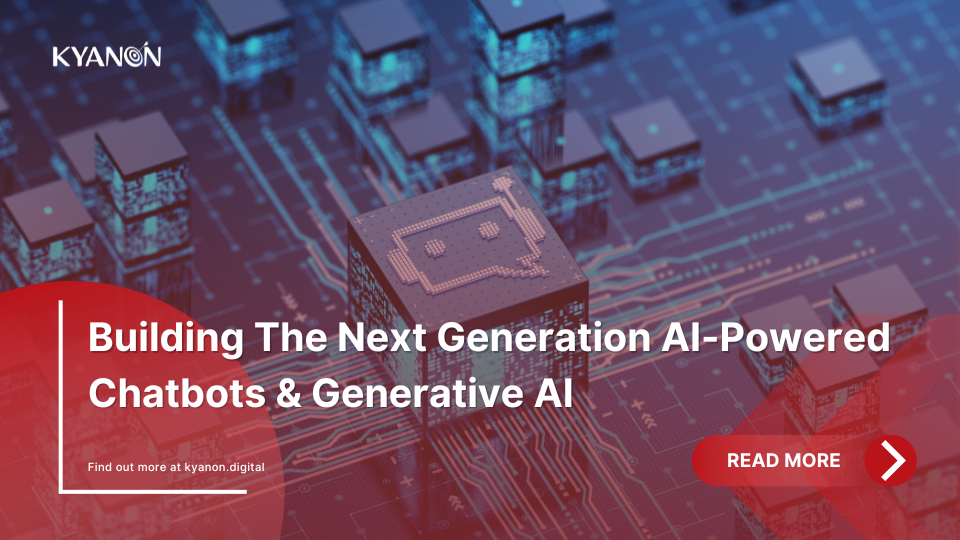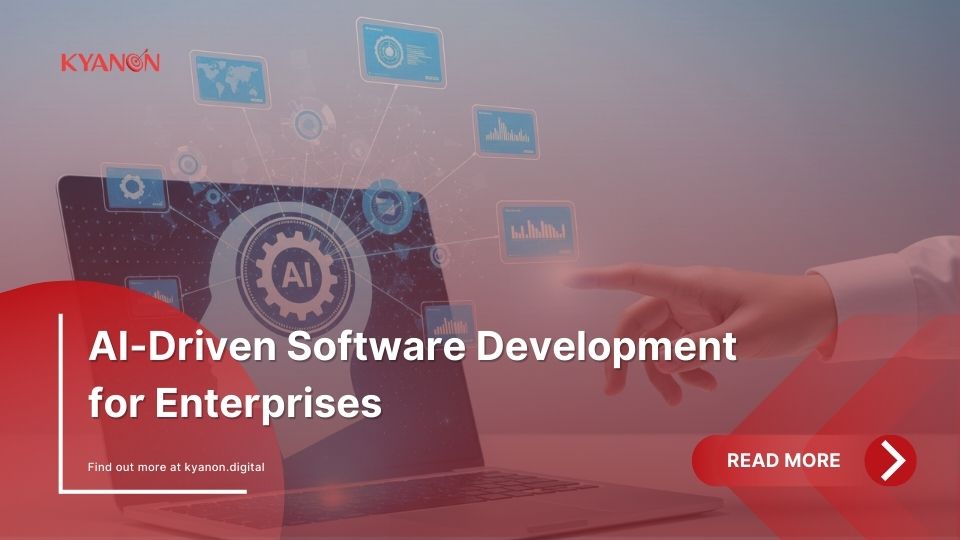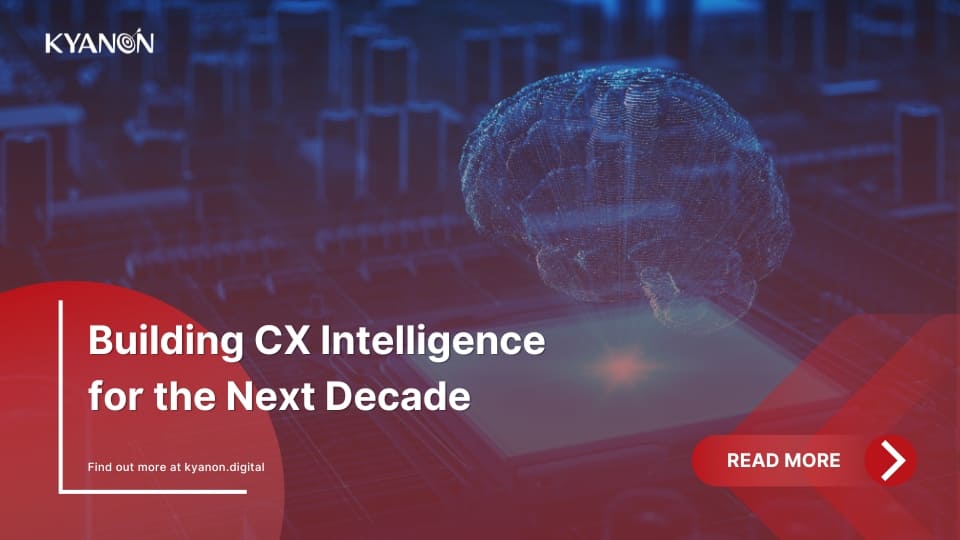In a digital era defined by immediacy and personalization, businesses are turning to AI assistant chatbots to deliver smarter, faster, and more human-like interactions. Whether you’re a product manager, CTO, or startup founder, the challenge lies in building scalable AI-based chatbots that go beyond scripted replies – chatbots that can learn, reason, and evolve. Did you know that 80% of customer interactions can now be handled by Artificial Inteligence without human intervention?
This blog explores how to build the next generation of generative AI chatbots, from development frameworks to real-world use cases – empowering you with the tools to innovate through AI assisted development. Read on to unlock the future of conversational AI.
Building the next generation of AI assistant chatbots
- The problem: Traditional chatbots struggle with limited understanding, rigid scripting, and poor scalability – failing to meet modern user expectations for real-time, intelligent interactions.
- The solution: AI assistant chatbots use NLP, LLMs, and machine learning to deliver contextual, human-like conversations across platforms and business functions.
- Development process: From defining use cases to training models and integrating systems, successful AI chatbot development follows a structured, multi-step approach optimized for agility and accuracy.
- Best practices: User-focused design, secure integrations, domain-specific training, and continuous optimization ensure high performance and long-term value.
- Real-world impact: Custom-built AI chatbots, like Kyanon Digital’s LegalTech solution, have reduced manual workloads by 60% and accelerated go-to-market for clients across regulated industries.
Further Reading
- Delivering a Seamless Customer Experience with Chatbots
- Low Code Development Platforms: Chatbots Driving CX!
- How to build your own AI model training services
What Is an AI Assistant Chatbot?
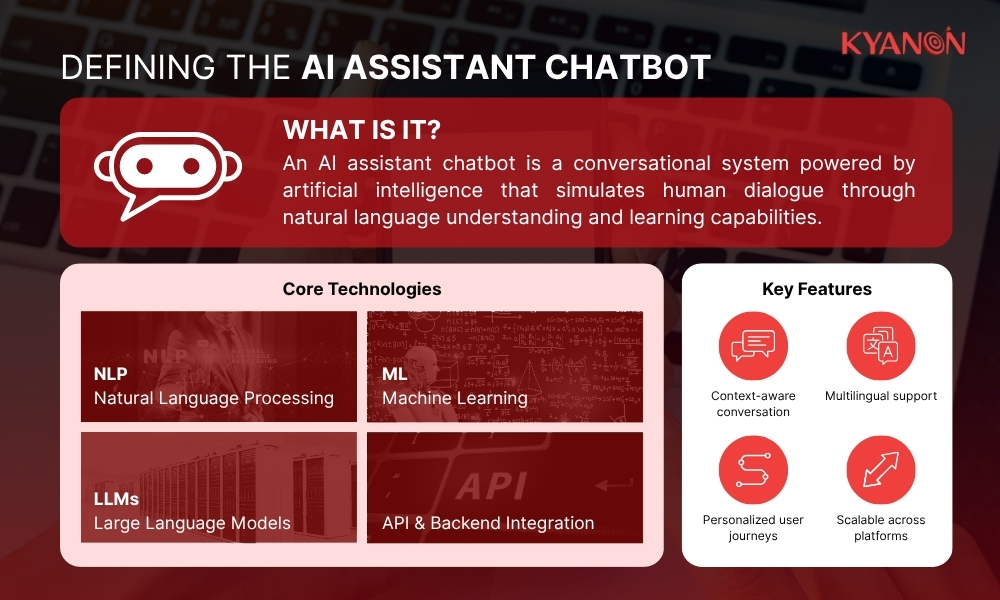
Definitions
An AI assistant chatbot is an intelligent, conversational agent powered by artificial intelligence technologies such as natural language processing (NLP), machine learning (ML), and large language models (LLMs). Unlike traditional rule-based bots that follow scripted flows, AI assistant chatbots understand context, intent, and even sentiment – enabling human-like interactions across multiple channels. These bots can be embedded in websites, mobile apps, messaging platforms, or voice assistants to automate customer support, streamline internal operations, or enhance user engagement. What distinguishes them from generic chatbots is their ability to learn from past interactions and dynamically adapt to user behavior over time.
Core features
Modern AI assisted chatbot development focuses on enhancing core capabilities such as contextual memory, multilingual communication, real-time integration with business systems, and continuous learning. Key features include conversational flow management, intent recognition, personalized recommendations, and seamless handoffs to human agents when needed. This architecture allows for more natural, accurate, and scalable engagement, aligning with today’s user expectations and digital-first strategies.
Business value
From a business perspective, AI-based chatbots create measurable value through reduced customer service costs, faster response times, and improved satisfaction scores. They also generate insights into customer behavior, helping companies refine offerings and personalize experiences at scale. For industries like retail, finance, and healthcare, AI chatbot solutions enable 24/7 support, ensure regulatory compliance, and unlock new channels for revenue generation – all while keeping human resources focused on higher-level tasks.
Real-world case: Klarna’s AI assistant handled 2/3 of customer chats in its first month
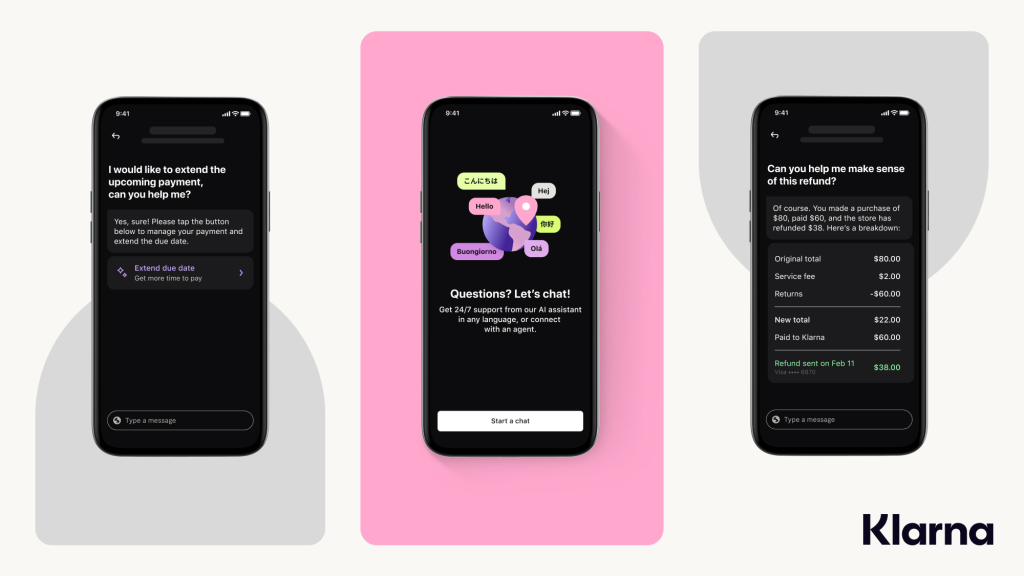
Klarna, a global leader in fintech and payment solutions, implemented an AI-powered customer service assistant to streamline support operations. Within the first month, the AI chatbot managed two-thirds of all customer service conversations, significantly reducing the load on human agents. This resulted in faster response times and higher customer satisfaction scores while also lowering operational costs.
By automating repetitive inquiries and enabling 24/7 service availability, Klarna’s AI solution exemplifies how AI-based chatbots can drive both efficiency and enhanced customer experience at scale.
Transform your ideas into reality with our services. Get started today!
Our team will contact you within 24 hours.
How to build a generative AI chatbot
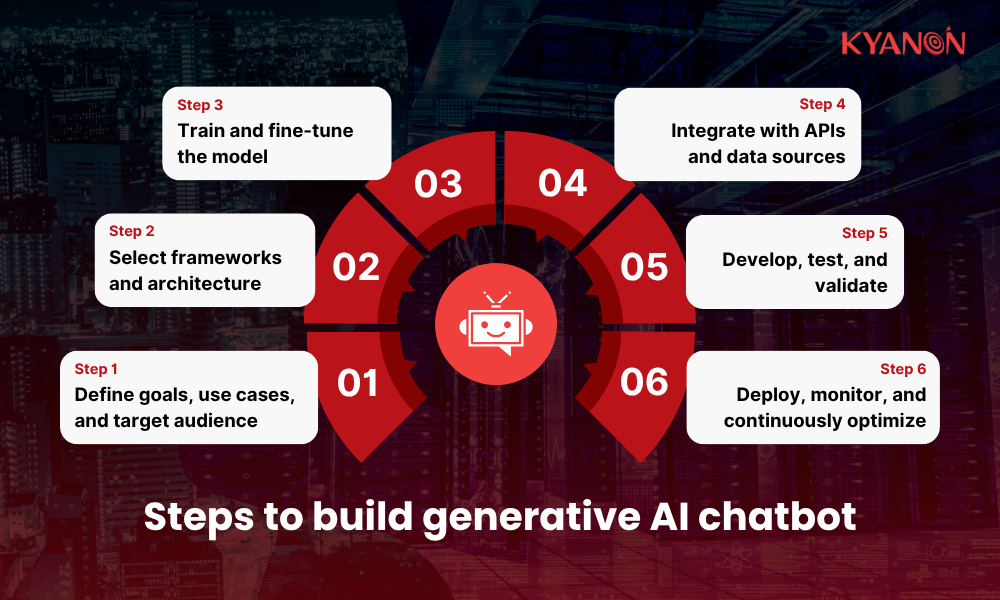
Step 1: Define goals, use cases, and target audience
Clarify the chatbot’s objectives by identifying the business problems it will address, such as customer support automation or sales assistance. Determine the specific use cases and understand the target audience’s needs to tailor the chatbot’s functionality and conversational style effectively.
Step 2: Select frameworks and architecture
Choose development tools and AI infrastructure, such as OpenAI, LangChain, Rasa, or Botpress. For generative AI chatbots, use LLMs like GPT or Claude, and define architecture for message routing, memory management, and fallback mechanisms.
Step 3: Train and fine-tune the model
Feed the model with high-quality, domain-specific data. Use prompt engineering or fine-tuning techniques to align responses with business logic. Retrieval-augmented generation (RAG) can be integrated for dynamic, up-to-date answers.
Step 4: Integrate with APIs and data sources
Connect the chatbot with CRMs, knowledge bases, or third-party services via secure APIs. This enables dynamic actions like checking order status, submitting tickets, or updating records—making the ai-based chatbot functionally useful, not just conversational.
Step 5: Develop, test, and validate
Build out conversation flows, implement fallback logic, and validate across different platforms. Run structured testing (unit, regression, UAT) and apply AI fairness, safety, and privacy audits to ensure production readiness in AI assisted chatbot development.
Step 6: Deploy, monitor, and continuously optimize
Launch across chosen channels like websites or messaging apps. Use analytics to track user behavior, identify failure points, and refine the system over time. Implement feedback loops to retrain models and scale based on performance data.
“The global chatbot market is projected to reach $46.64 billion by 2029, growing at a compound annual growth rate (CAGR) of approximately 24.5% from 2024 to 2029. Currently, over 987 million people use AI chatbots worldwide, and businesses are expected to save up to $11 billion and nearly 2.5 billion hours annually by leveraging chatbot automation.” – GlobeNewswire
AI assisted chatbot development services
Overview of professional services
AI assisted chatbot development services provide end-to-end support for businesses looking to implement intelligent conversational solutions at scale. These services leverage natural language processing (NLP) and machine learning to enable bots that can understand user intent, provide meaningful responses, and perform automated tasks – reducing the need for manual intervention in repetitive workflows.
With the growing demand for AI assistant chatbot solutions, development partners also offer ongoing model training, performance monitoring, and post-deployment optimization. These professional services ensure not only faster time-to-market but also the flexibility to scale and evolve the chatbot in response to user behavior and business growth.
Choosing the right frameworks for scalable AI assistant chatbot solutions
Selecting the right framework is a crucial part of AI assistant chatbot development, as it determines the chatbot’s capabilities, scalability, and ease of integration. Various proprietary and open-source frameworks offer distinct features tailored to different business needs and technical requirements.
The following table provides a concise comparison of leading frameworks commonly used in AI assisted chatbot development, highlighting their key features and ideal use cases to help guide informed decision-making.
| Framework | Key features | Best use cases |
| Rasa | Open-source, customizable NLU & dialogue management, strong data control, supports on-premises deployment | Regulated industries, custom AI workflows, privacy-focused organizations |
| Botpress | Visual flow builder, modular architecture, supports LLM plugins, open-source, extensible | Mid-size to enterprise projects, hybrid bots, organizations needing visual design tools |
| Microsoft Bot Framework | Enterprise-grade SDK, native Azure integration, supports rich media/channels, multi-language | Enterprise bots, Microsoft ecosystem users, omnichannel customer service |
| Google Dialogflow | Pre-trained intents, voice + text, fast Google integration, multi-language, easy deployment | Quick deployments, customer support bots, cross-platform virtual assistants |
| Amazon Lex | Built-in ASR/NLU, AWS native services, multichannel deployment, scalable, pay-as-you-go | E-commerce, customer service automation, businesses on AWS infrastructure |
Comparison of common AI assistant chatbot frameworks
Best practices for high-performing AI assistant chatbot development
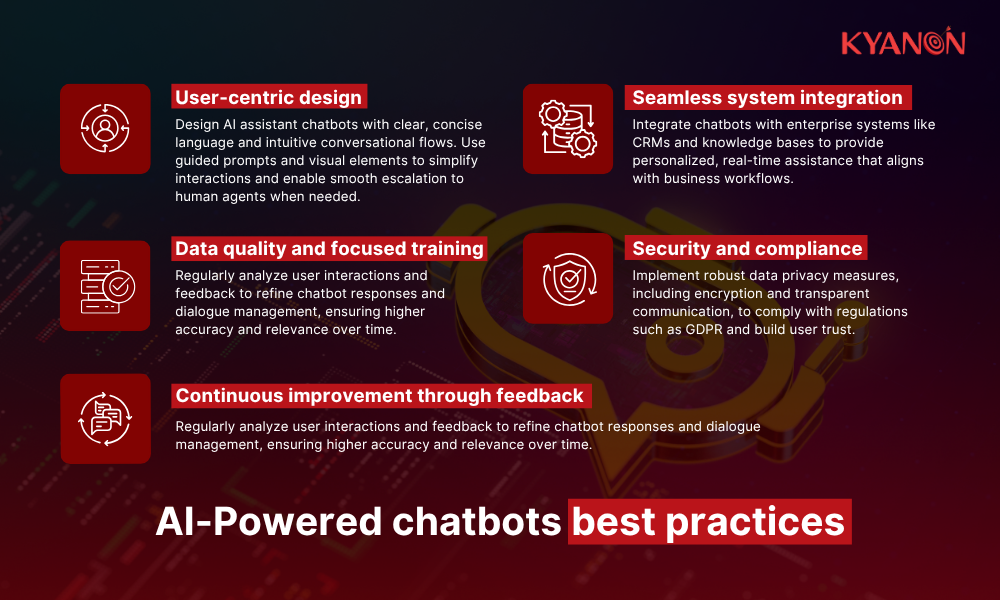
Building high-performing AI assistant chatbots requires more than just integrating a large language model – it demands thoughtful design, quality training, and secure deployment. The following best practices are essential for delivering scalable, user-centric solutions that generate long-term business value.
User-centric design
Conversations should feel natural and goal-oriented. Use simple language, logical flows, and visual UI elements like buttons or quick replies to guide users efficiently. When complexity arises, ensure a smooth transition to human support. Well-designed interaction paths reduce drop-offs and increase task completion rates – key outcomes of effective AI assisted chatbot development.
Continuous improvement through feedback
User behavior reveals friction points. Analyze chat logs, dropout points, and satisfaction scores to refine dialog handling and intent detection. Apply regular updates to improve accuracy and reduce confusion, helping your AI chatbot stay relevant as user expectations and language evolve.
Data quality and focused training
Training datasets should reflect your domain and use case. Curated, task-specific data improves the chatbot’s ability to interpret complex queries and respond with precision. Avoid flooding the model with irrelevant examples – focused learning ensures AI-based chatbots produce consistent, high-confidence answers in production.
Seamless system integration
A chatbot is only as useful as the systems it connects to. When integrated with CRMs, databases, or ERP platforms, it can perform actions like retrieving order statuses, submitting forms, or checking user profiles. In enterprise-grade AI assisted development, integration transforms chatbots into fully functional digital agents.
Security and compliance
Users trust systems that protect their data. Implement encryption, access control, and privacy settings aligned with GDPR or HIPAA to safeguard sensitive information. For AI assistant chatbots handling personal or transactional data, security-by-design is critical for adoption and long-term success.
Custom AI chatbot use cases and examples
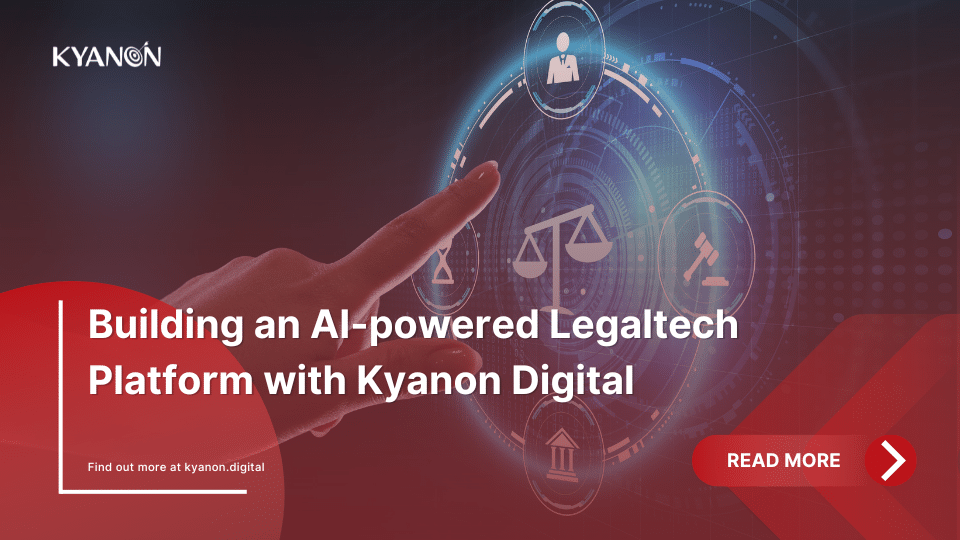
See how Kyanon Digital helped a LegalTech innovator launch a fully functional AI-powered contract assistant MVP here.
In this project, Kyanon Digital designed and implemented a custom chatbot solution to address the inefficiencies in contract review and legal document management. The chatbot used advanced NLP models to interpret complex legal language and return accurate, context-specific answers to user queries. By integrating with the client’s internal knowledge base and third-party data sources, the solution enabled instant access to clause summaries, obligations, and compliance risks – features critical to fast-paced legal and regulatory environments. The implementation also included intelligent handoff protocols, allowing seamless transitions to human agents for nuanced cases.
Unlike general-purpose AI-based chatbots, this solution was built with domain-specific fine-tuning and a microservices backend to ensure long-term scalability. It supported role-based access control, full audit trails, and multilingual capabilities to serve a diverse, global user base. The result was a powerful AI assistant chatbot that not only reduced manual legal workload by up to 60%, but also accelerated the client’s go-to-market strategy by offering a differentiated, AI-driven feature set within their LegalTech SaaS platform.
Kyanon Digital: Your trusted AI Implementation partner

As a trusted leader in AI development, Kyanon Digital delivers tailor-made AI solutions ranging from intelligent chatbots and data extraction tools to advanced business automation systems. Our expertise extends to AI model selection, development, training, and ongoing optimization, ensuring seamless performance and long-term value.
What makes Kyanon Digital different?
- Human-Centric Design: We design solutions that are intuitive, impactful, and crafted to solve real-world challenges while enhancing user experiences.
- Engineering Excellence: With our Center of Excellence (CoE) driving innovation, we deliver scalable, reliable, and future-ready digital solutions.
- High-performance Agile Teams: Our expert teams seamlessly integrate with yours, combining technical expertise, agile mastery, and transparent collaboration to deliver adaptable, high-impact results.
Conclusion
As businesses strive to deliver faster, smarter, and more scalable user experiences, AI assistant chatbots have emerged as a transformative solution across industries. In this blog, we explored what defines an AI-powered assistant chatbot, how to build generative AI chatbots step by step, and the professional services and frameworks required to bring them to life. We also examined best practices – from user-centric design to security compliance – and showcased a real-world case study in LegalTech that highlighted the power of tailored AI chatbot solutions to drive operational efficiency and innovation.
Whether you’re a fintech startup launching your first MVP or an enterprise scaling digital support channels, investing in AI assisted chatbot development gives you a competitive edge in automation, customer engagement, and service delivery. With the right strategy, tools, and partner, your business can harness the full potential of intelligent conversation.
Ready to build your own AI-powered chatbot? Contact Kyanon Digital today to discuss your vision.
References
- What are chatbots and why are they important?, IBM
- Agentic AI: Gartner predicts 80% of customer problems solved without human help by 2029, CX Today
- How to create a generative AI chatbot, Biz4Group
- How to build your own AI chatbot, Botpress
- How to build an AI chatbot using LLM, LeewayHertz
- AI chatbot development services: Transforming customer engagement, Zartis
- Rasa documentation, Rasa
- Botpress documentation, Botpress
- Microsoft Bot Framework Overview Microsoft
- Dialogflow documentation, Google Cloud
- Amazon lex documentation, AWS
- AI-powered legaltech platform case study, Kyanon Digital
- How to make an AI chatbot, SolveIt
- Chatbot UX tips: How to make it useful and human, Netguru
- AI chatbot market projected to reach $46.64 billion by 2029, GlobeNewswire
- Chatbot statistics 2024, Exploding Topics
- Klarna AI assistant handles two-thirds of customer service chats in its first month, Klarna

